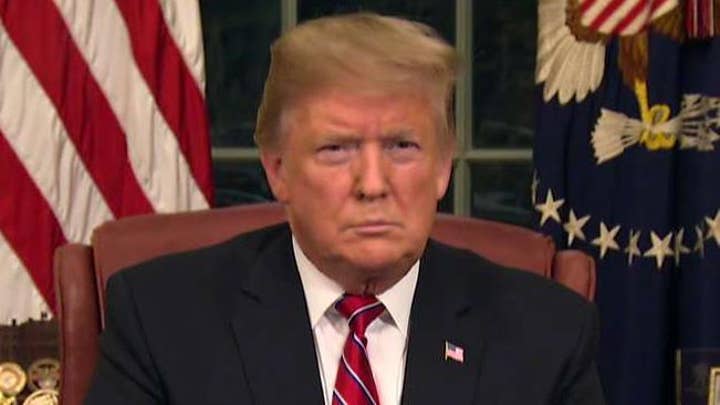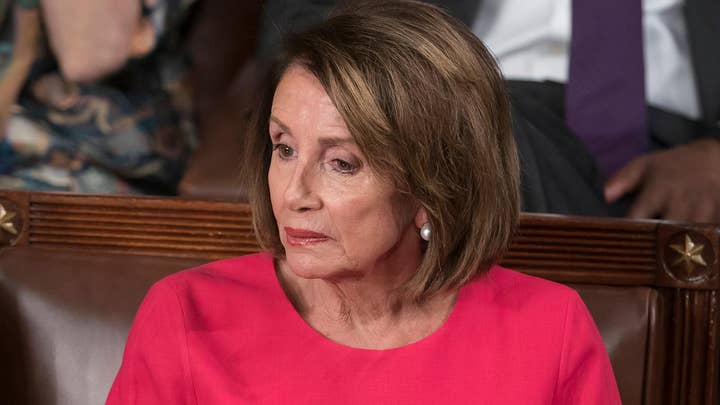The partial government shutdown became the longest in history as President Trump and Democratic lawmakers refused to compromise and pass a spending bill – with funding for a border wall at the crux of the fight.
The government partially shuttered at midnight on Dec. 22. The shutdown affects about one-quarter of the government, including nine Cabinet-level departments. It has also culminated in some 800,000 federal employees off the job or working without pay.
Trump repeatedly vowed not to reopen the government without $5.7 billion for the wall. Democrats have refused to capitulate and have favored measures that would bolster border security as a whole instead of a concrete wall.
There’s growing concern about the toll the shutdown is having on Americans, including disruptions in payments to farmers, trouble for home buyers seeking government-backed mortgage loans and uncertainty over food assistance programs.
The traditional State of the Union address is also in limbo over the shutdown.
Here is a brief timeline of what has happened throughout the weeks-long shutdown.
Jan. 25 – Trump announces deal to open government
Trump said he would support a short-term spending bill to re-open the government, temporarily ending the partial government shutdown, despite saying a day earlier that Republicans would not "cave" on demands for the border wall.
The deal would keep the government open for three weeks, and a bill will go to the Senate immediately, Trump said. He made reference to his previous threats to declare a national emergency, calling it a "very powerful weapon," but saying he didn't want to use it. The deal appeared to include no money for a wall or steel barrier, but he said he hoped negotiations would continue to come to an agreement on wall funding.
Trump thanks federal workers who haven't been receiving a paycheck and promised they'd get their money "very quickly."
Jan. 23 – The state of the State of the Union
After some back and forth between Trump and House Speaker Nancy Pelosi, the president decided to postpone the State of the Union until after the shutdown is over. Pelosi had already told Trump the House would not approve a resolution allowing him to come to Capitol Hill to give the annual address until the government reopens.
"As the Shutdown was going on, Nancy Pelosi asked me to give the State of the Union Address. I agreed," Trump said in a tweet. "She then changed her mind because of the Shutdown, suggesting a later date. This is her prerogative - I will do the Address when the Shutdown is over."
Jan. 22 – Trump instructs Republicans to not 'cave'
With the government officially partially shuttered for one month, Trump continued to pressure Republicans to pass a spending bill that includes funding for a border wall.
"Without a Wall our Country can never have Border or National Security. With a powerful Wall or Steel Barrier, Crime Rates (and Drugs) will go substantially down all over the U.S.," Trump said in a tweet. "The Dems know this but want to play political games. Must finally be done correctly. No Cave!"
Jan. 19 – Trump floats deal to end shutdown
As the shutdown nears the one-month mark, Trump floated an immigration compromise to Democrats to reopen the government. He said he was prepared to back a three-year extension of protections for the nearly 800,000 immigrants who entered the country illegally and shielded from deportation under the Obama-era Deferred Action for Childhood Arrivals (DACA). The deal would also extend protections for the 300,000 recipients of the Temporary Protected Status (TPS) program.
This would be in exchange for the $5.7 billion he's demanded for a border wall.
The proposal was quickly dismissed by Democrats, including Pelosi who said called the proposal a "non-starter" even before Trump's weekend speech.
Jan. 17 – Trump benches Pelosi
Trump abruptly canceled a planned foreign trip Pelosi was to take just minutes before the congressional delegation was set to depart. In a curt letter, Trump denied Pelosi the use of military aircraft for the trip, saying it's been "postponed" due to the shutdown.
“I also feel that, during this period, it would be better if you were in Washington negotiating with me and joining the Strong Border Security movement to end the Shutdown," Trump said. "Obviously, if you would like to make your journey by flying commercial, that would certainly be your prerogative.”
CLICK HERE TO READ TRUMP'S LETTER TO PELOSI
The move came a day after Pelosi suggested he delay the upcoming State of the Union address.
Jan. 16 – House Speaker encourages Trump to delay State of the Union
Pelosi asked Trump to either delay the upcoming State of the Union address or simply submit the speech in writing, something past presidents have done, if the shutdown continues.
STATE OF THE UNION HISTORY, RECORDS AND OTHER FUN FACTS
Trump is scheduled to give the traditional address on Jan. 29.
Jan. 12 – Shutdown breaks record
On Jan. 12, the government had been partially shuttered for 22 days, breaking the record for the longest in history.
Previously, the longest shutdown was 21 days, occurring during President Bill Clinton's administration from December 1995 to January 1996.
Jan. 10 – Trump travels to the southern border
In a continued push for the wall, Trump traveled to the southern border on Jan. 10. He escalated warnings that he could circumvent Congress and declare a national emergency to get his wall built if a deal can’t be made.
Jan. 9 – Trump walks out of meeting with Democrats
Pelosi again rejected a plan to include Trump’s requested funding for a border wall, the president abruptly left the meeting with congressional leaders at the White House. In a tweet, Trump called the Jan. 9 meeting a “total waste of time.”
ANTI-SEXUAL VIOLENCE GROUPS FEEL ‘PINCH’ AS GOVERNMENT SHUTDOWN CONTINUES
“I asked what is going to happen in 30 days if I quickly open things up, are you going to approve Border Security which includes a Wall or Steel Barrier? Nancy said, NO. I said bye-bye, nothing else works,” Trump said.
The House also passed a bill that would fund the Treasury Department, IRS and a bevy of other agencies through the next year as part of Democrats’ plan to reopen the government on a piecemeal basis. However, it is unlikely to advance through the Senate.
Jan. 8 – Trump gives first Oval Office address
Trump delivered the first primetime address from the Oval Office during his presidency on Jan. 8, calling for the border wall and decrying what he perceives as the “growing humanitarian and security crisis” of surging illegal immigration.
Following his address, Pelosi and Sen. Chuck Schumer derided Trump’s rhetoric and “obsession” with the wall.
REPUBLICAN CONGRESSMAN CALLS ON TRUMP TO USE ‘OWN FUNDS’ TO HELP PAY FOR BORDER WALL
“There is an obvious solution: separate the shutdown from the arguments over border security. There is bipartisan legislation – supported by Democrats and Republicans – to re-open the government while allowing debate over border security to continue,” said Schumer.
Jan. 6 – Trump floats steel wall as compromise
Trump suggested using steel to build the border wall instead of concrete in what he framed as a concession to Democrats. On Twitter, he said it was a “good solution.”
Jan. 4 – Trump warns shutdown could last for ‘years’
After meeting with congressional leaders at the White House on Jan. 4, Trump warned the shutdown could last for “years” unless he can come to an agreement with Democrats over the border wall funding. He also floated the possibility of declaring a national emergency to get his wall built.
Jan. 3 – House Democrats pass legislation to reopen government
After gaining control of the House, Democrats passed a few bills on Jan. 3 that would have reopened the federal government. However, the package did not include funding for the border wall – making it moot.
PARTIAL GOVERNMENT SHUTDOWN PREVENTS COUPLE FROM GETTING MARRIAGE LICENSE IN DC
Senate Majority Leader Mitch McConnell said he will refuse to “take up any proposal that does not have a real chance of passing this chamber and getting a presidential signature.”
Dec. 31 – Federal workers union files lawsuit

A federal workers union filed a lawsuit in December against the federal goverment alleging workers who earned overtime have not been paid on time amid the shutdown and are entitled to liquidated damages. (AP Photo/J. Scott Applewhite)
The American Federation of Government Employees filed a lawsuit against the federal government on Dec. 31, alleging workers who earned overtime have not been paid on time amid the shutdown and are entitled to liquidated damages.
The law firm representing the union won a similar case during the 2013 government shutdown.
Dec. 22 – Partial government shutdown triggered
Without a spending deal, the government partially shuttered at midnight on Dec. 22. Only about a quarter of the government was affected by the shutdown, including nine Cabinet-level departments.
Fox News’ Sally Persons, Gregg Re, Adam Shaw, Brooke Singman and The Associated Press contributed to this report.

























